June 7: Ebola epidemic “appears to be under control”
After many weeks of intense local, national, and international response efforts, the Ebola outbreak in the Democratic Republic of the Congo (DRC) appears to be under control. Health care responders, partners, and investigators, in cooperation with the DRC Ministry of Health, continue to conduct intensive surveillance to find the source of the epidemic and any more victims.
In a letter sent on June 2, the country’s Minister of Health, Oly Ilunga Kalenga, wrote: “At this stage, we can say that the spread of the epidemic has been controlled and it is thanks to the quality of national and international experts in the health zone, thanks to the rapid health response coordinated at the central level, and probably also due to other factors related to the local context, which still have to be the subject of scientific investigations.”
According to the most recent World Health Organization situation update, there are currently a total of five confirmed and three probable cases of whom four have died. While the outbreak appears to be under control, there remain other variables that could affect the containment.
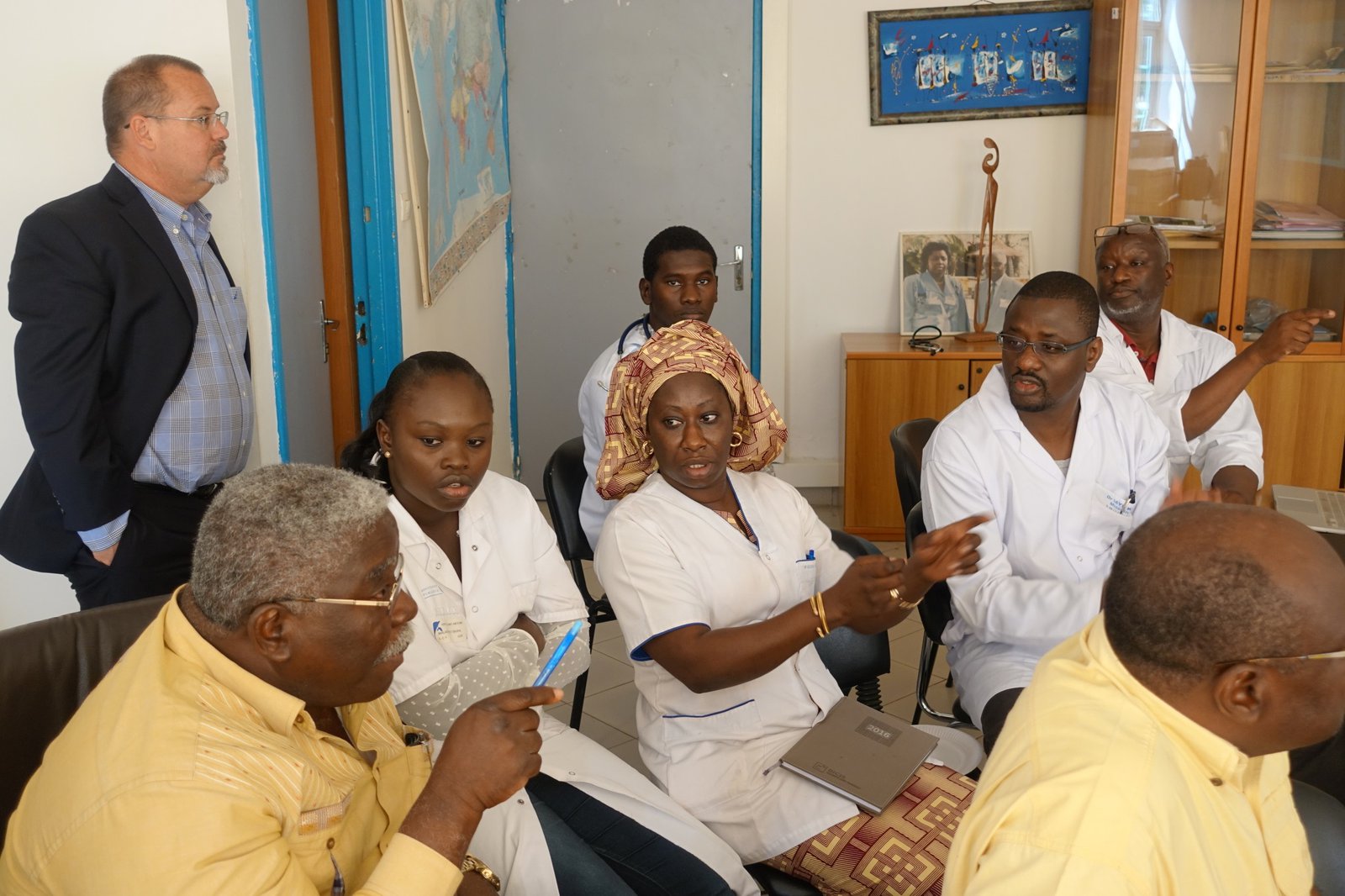
Trad Hatton (top left), PATH’s country leader in the Democratic Republic of the Congo (DRC) and Dr. Benoit Kebela (bottom left), the director of the DRC’s Department of Disease Control, met last year.
“The DRC Ministry of Health and its international partners have made important headway and we feel a collective sense of relief that the Ebola epidemic appears to be under control. We salute those on the front lines in health facilities and local communities who, when supported by DRC epidemic investigators from Kinshasa, were able to do what was necessary to prevent an explosive epidemic. We must remain vigilant and supportive of these local heroes for extended surveillance in case unexpected cases of Ebola do appear,“ said Trad Hatton, DRC country director for PATH.
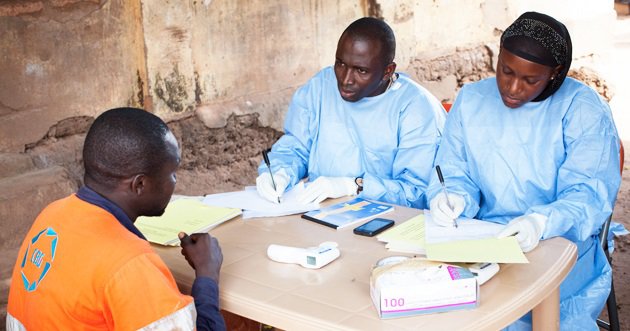
Although hopeful that the Ebola outbreak is being successfully contained, investigators will continue to search for people who have been in contact with Ebola patients for another 60 days and try to determine the source of the current outbreak.
June 1: Tracking the epidemic’s source
With no new Ebola cases confirmed since May 11, officials with the Ministry of Health (MOH), the World Health Organization (WHO), and other partners are hopeful that the outbreak is being successfully contained, thanks to an improved alert and response system, better mapping to get supplies and responders in place quickly and efficiently, and the use of a mobile laboratory and rapid diagnostic tests developed since the 2014 West Africa outbreak.
“It is really wonderful to see the solidarity in this response to the Ebola outbreak,” said Linda Venczel, director of PATH’s Global Health Security program in the Democratic Republic of the Congo (DRC) and three other countries. “The fact that there are no new cases is a tribute to faster response and better surveillance than ever before.”
There are 17 suspected cases of Ebola waiting confirmation, and teams of epidemiologists are still searching out all people who may have had contact with Ebola victims, according to Dr. Hermann Tchiyane, an expert on Ebola and PATH’s representative on the DRC’s Ebola Surveillance Commission. “Active surveillance is ongoing because we are suspecting more deaths to have occurred in the community before the index case was identified,” he said.
Dr. Benoit Kebela, the director of the DRC’s Department of Disease Control, confirmed that investigators would continue actively searching for people who have been in contact with Ebola patients for another 60 days. “We must seek to know exactly the origin of the first case to avoid another epidemic,” he said.
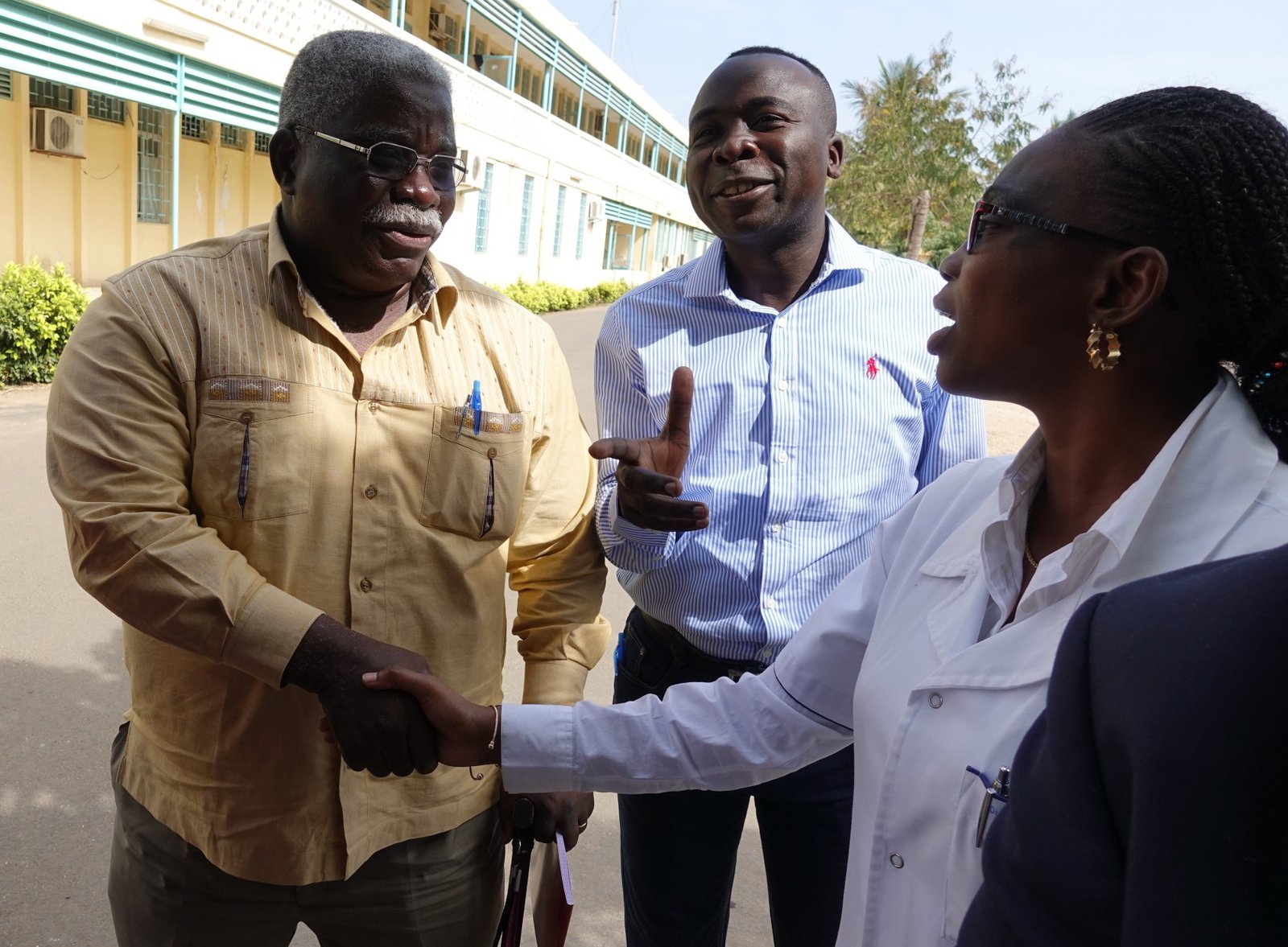
Dr. Benoit Kebela (left), the director of the DRC’s Department of Disease Control, shakes hands with Dr. Aissatou Ndaye Lakhe, assistant chief of service at Infectious Disease Service at Fann University Hospital in Senegal.
According to Dr. Kebela, investigators have been interviewing local healers and community leaders to understand the history of the current outbreak. They are also tracking the route the first-known Ebola victim traveled to determine if he acquired Ebola from someone else or passed it on to others.
“This vigilance will need to stay high with ongoing polio and measles outbreaks in the DRC, as well as cholera in East Africa,” said Linda. “It also shows the importance of epidemic preparedness.”
There are now two separate outbreaks of circulating vaccine-derived poliovirus type 2 in southeastern DRC, which are a setback to global elimination efforts. WHO, the DRC’s MOH, and other partners including PATH are moving quickly to limit the spread.
Vaccine-derived poliovirus outbreaks happen very rarely when population immunity is low, leaving large swathes of people vulnerable. The region where the outbreaks have occurred has the lowest level of vaccination coverage in the DRC.
With type 2 poliovirus eradicated in the world, countries switched to a bivalent form of oral poliovirus vaccine (OPV) that does not contain the type 2 component to reduce the risk of the vaccine-derived form. Now that it has reemerged, the stakes are high to ensure that it is quickly contained. The DRC is planning the implementation of house-to-house campaigns with monovalent type 2 vaccine to reach high coverage and stop the outbreak.
PATH is helping to establish the first emergency operations center (EOC) in the DRC, which will help coordinate public health emergencies like these. As part of this effort, Dr. Gaston Tshapenda, an epidemiologist with the Ministry of Health, spent four months at the Centers for Disease Control and Prevention in Atlanta doing the intensive Public Health Emergency Management training. Newly returned to the DRC, he will manage the new EOC.
In other news, regulatory and ethics-review boards of the DRC approved the use of the experimental Ebola vaccine should need arise. The vaccine—called rVSV-ZEBOV—had languished in development for almost two decades, and was then fast-tracked during the 2014 outbreak.

Ebola responders and health care workers in the Likati Health Zone will receive three MSR Community Chlorine Makers (the device pictured here) to help disinfect water, tools, and equipment at emergency clinics and mobile laboratories.
May 26: Responding to a critical need for chlorine to help prevent the spread of Ebola
The effort continues to stop the spread of the Ebola virus in the Democratic Republic of the Congo (DRC). According to the most recent World Health Organization (WHO) situation update, the latest suspected case was reported on May 23, while an additional 101 people who were exposed to the virus are now being monitored.
The PATH global health security team is working closely with its partners and the DRC country team to identify and address public health, surveillance, and monitoring needs. Responders, health care workers, and the community affected by the outbreak in Likati need a way to disinfect water, tools, equipment, bedding, and burial supplies to prevent further spread of the Ebola virus. There have been reports of critical chlorine shortages from the field, hindering the ability to conduct disinfection at emergency clinics and mobile laboratories where samples are being tested.
In response, PATH reached out to Mountain Safety Research® (MSR), a longstanding partner who we collaborated with to develop the MSR Community Chlorine Maker, a portable device that can produce chlorine in just five minutes. The chlorine maker can produce up to 4 liters of chlorine a day using water and salt, and is powered by a local power source, such as a motorbike battery. MSR has agreed to donate three of the devices to PATH to support the outbreak response, and we’ll be sending them to the Likati area to help fill the chlorine shortage.
The Ministry of Health and other organizations working in the region are trying to overcome transport and logistics challenges. Crews are working to improve roads where possible and create boat transport solutions where roads are impassable in order to reach remote communities. Teams are also distributing protective equipment to health facilities throughout the entire Likati Health Zone and border areas.
WHO has also issued a donor alert for US$10.5 million to fund response activities that range from surveillance and infection control (including training communities on safe burial) to the possibility of emergency vaccination. According to WHO, the government of the DRC, Médecins Sans Frontières (Doctors Without Borders), and other partners are preparing to offer access to the experimental Ebola vaccine (officially known as rVSV-ZEBOV). No decision has been made to use the vaccine and approval from the DRC’s regulatory authority and ethics review committee would be required before proceeding.
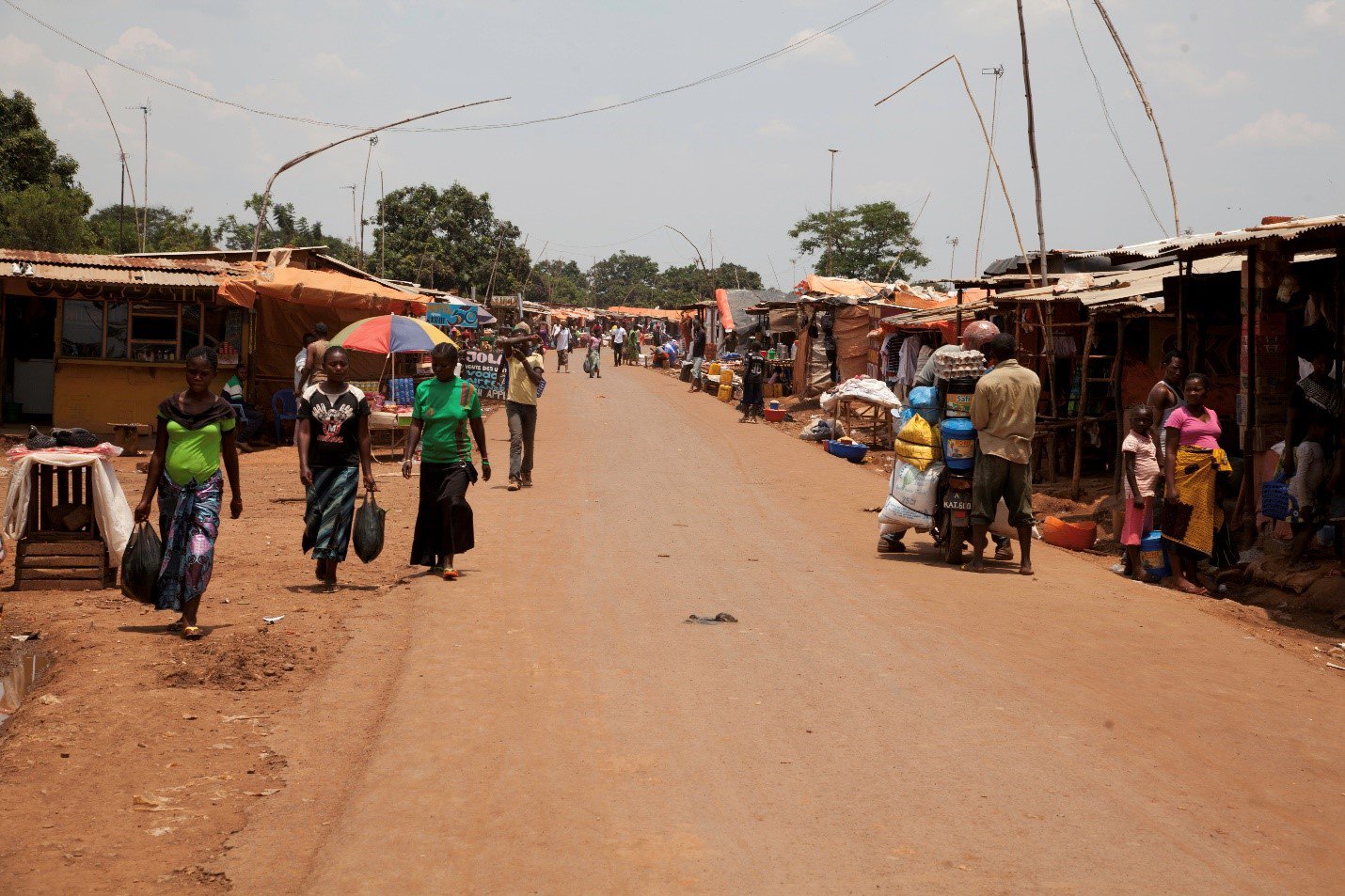
In much of the Democratic Republic of the Congo there are no electric or telephone lines nor cell coverage. This photo was taken on the outskirts of Kinshasa, the country’s capitol.
May 25: Congo’s inability to communicate internally is a risk to the world
This latest outbreak of Ebola reaffirms the need for better preparedness to respond to emergencies, said Trad Hatton, PATH’s leader in the Democratic Republic of the Congo, in a call with PATH headquarters.
“One of the biggest lessons is that Congo needs to be digitized to have better surveillance systems and faster emergency response,” he said. “Congo’s inability to communicate with itself is a potential risk to the world.”
Read more of Trad’s report, from the human cost of this outbreak to how lessons learned could help prevent future ones, in this Q&A.
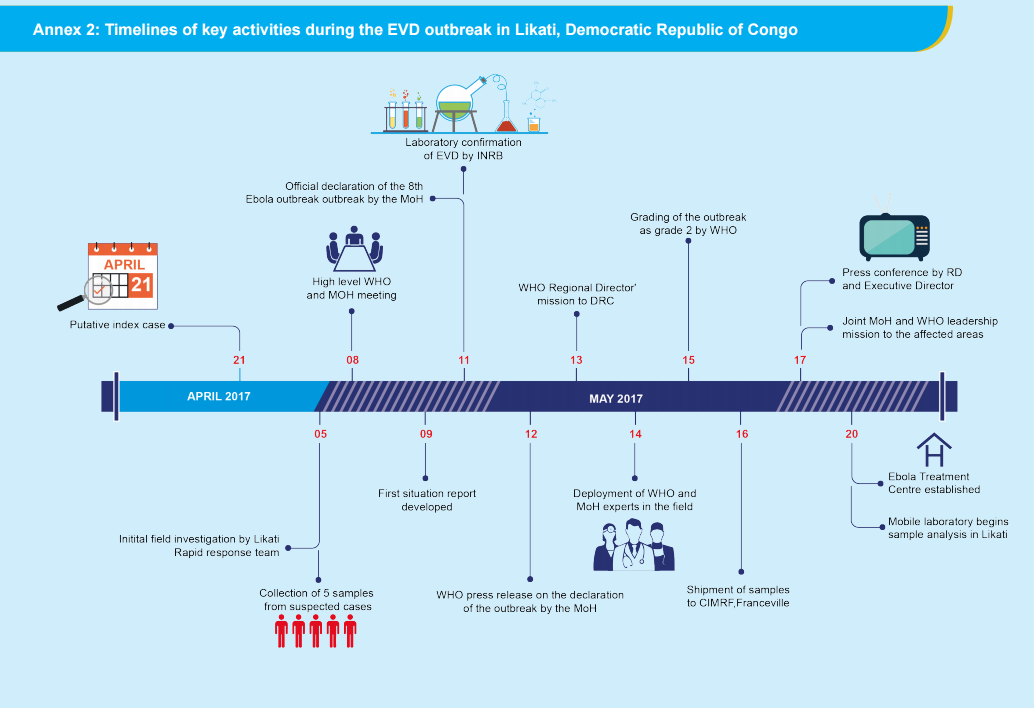
A timeline of response activities during the recent Ebola outbreak in the Democratic Republic of the Congo (DRC). Illustration: World Health Organization (WHO).
May 22: US$14 million needed to respond to Ebola outbreak
The latest World Health Organization (WHO) situation update reports that 43 people have been identified with suspected Ebola virus disease with four deaths confirmed. The disease remains confined to the Likati Health Zone, in the northern Democratic Republic of the Congo (DRC). Response teams are now involved with surveillance activities throughout the area to determine if and where there are more cases of Ebola.
WHO also confirmed that 362 individuals remain under daily monitoring for signs and symptoms of Ebola. Another 54 completed the follow-up period and are considered Ebola-free.
To control the outbreak, the DRC government is requesting $14 million from the global community for a comprehensive national response plan. In response, WHO and partners are developing a strategic plan to coordinate the support of international partners and stakeholders.
Meanwhile, infrastructure and other logistical barriers remain a challenge. A mobile lab in the town of Likati is processing samples from those suspected with Ebola. Another mobile lab is on its way to a more rural area so lab samples can be processed in the field.
PATH and our partners are working with provincial authorities on community awareness efforts to notify people about the outbreak and how to avoid spreading the disease.
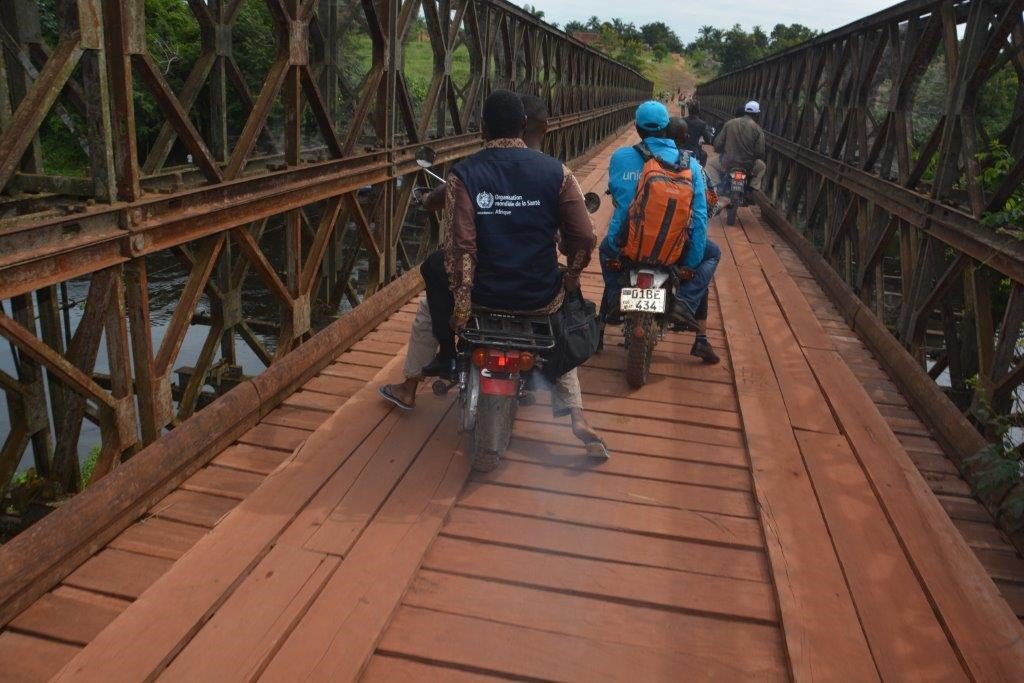
PATH arranged for a group of first responders—three doctors, a lab technician, and a communications officer—to travel to the epicenter of the Ebola outbreak in northern DRC.
May 19: First responders are on the ground
As officials arrive at the epicenter of the most recent Ebola outbreak in the Likati Health Zone in northern DRC, the latest World Health Organization (WHO) reports show a rise in confirmed cases.
A helicopter with supplies and the first five responders was flown into the area by WHO, followed by a second group coordinated and supported by PATH.
Now that the first responders are on the ground, work is focused on fanning out into largely unmapped territory to assess how far the disease has spread and to identify people who may have been exposed and potentially infected by the virus. In addition, Doctors without Borders (Médecins Sans Frontières) has set up an Ebola treatment center at the Likati General Hospital, and health workers have been given protective gear.
PATH is now focused on helping to build communication networks as quickly as possible in an area with almost no electricity or connectivity.
May 17: Ebola confirmed in the DRC
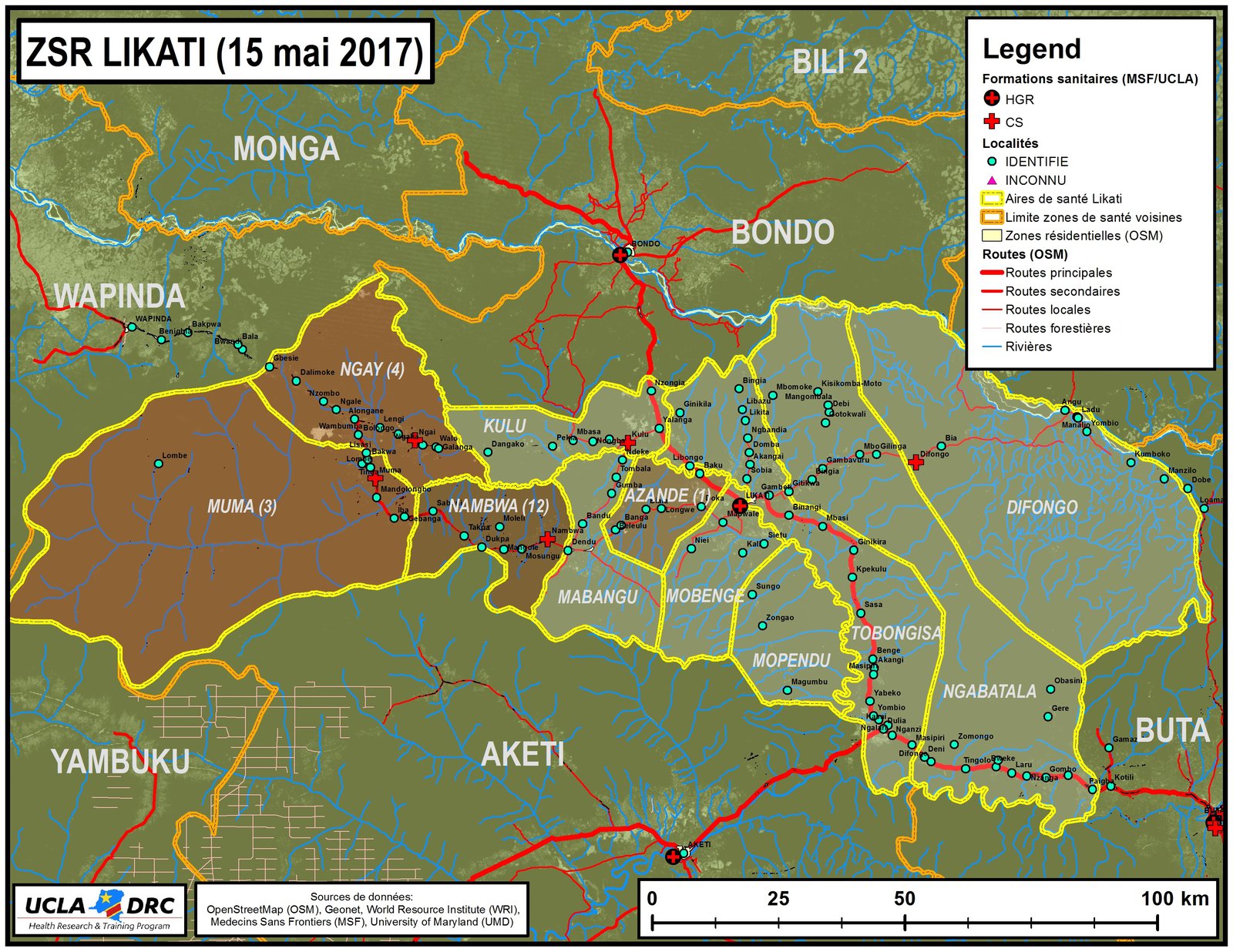
This map shows the Likati health district where the Ebola outbreak was confirmed in the Democratic Republic of the Congo (DRC).
Late last week, PATH received unofficial reports of an Ebola outbreak in the Likati Health Zone of the Democratic Republic of the Congo (DRC), a difficult-to-reach area near the Central African Republic border. By Friday, the World Health Organization (WHO) confirmed that three people had already lost their lives to the deadly virus, with nine more infected.
Within 24 hours, PATH was working alongside partners at the University of California, Los Angeles (UCLA), DRC Research program and our in-country partners to notify and engage DRC government officials, provide supplies and equipment, and prep and transport teams to the field to investigate the outbreak. A coalition of other organizations, including Médecins Sans Frontières (MSF), World Health Organization (WHO), and the Centers for Disease Control and Prevention (CDC), are also actively engaged in supporting the government’s response.
Currently, we are helping transport Ministry officials to the Likati Health Zone, providing GPS-enabled phones for use by frontline health workers for case identification and contact tracing, and offering technical assistance to the DRC government through its disease surveillance commission. PATH helped mobilize a cross-sector group of international partners to support the government with high-resolution satellite imagery, geospatial mapping capabilities, and other tools to help map and investigate the outbreak.
We are also working with partners in the DRC to accelerate the launch of a new emergency operations center in order to coordinate the response in public health emergencies such as this Ebola outbreak.
Our world is highly connected. Outbreaks like this one illustrate the global urgency to prepare against pandemic threats. Since 2015, PATH has been a grantee under the Global Health Security Agenda (GHSA), an initiative funded by the CDC. PATH works with governments and other partners in over 50 countries, contributing to overall global health security objectives to ensure each country is equipped to prevent, detect, and respond to outbreaks.
What’s happening now
We have engaged partners such as DigitalGlobe and drone experts at WeRobotics to help pinpoint the outbreak and its spread. For instance, DigitalGlobe had its satellites take new, high-resolution imagery of the affected area and made available archived high-resolution imagery of the affected area for mapping efforts so health officials can quickly respond to cases and contacts.
WeRobotics offered to deploy unmanned aerial vehicles (UAVs, or drones) to help obtain even higher-resolution imagery from the specific area where cases are occurring. By June, WeRobotics may be able to supply longer-range drones capable of transporting light-weight cargo to assist in the rapid delivery of medical supplies. These tactics depend on a range of factors, however, such as size of coverage area, flight permissions, funding, duration, and other variables.
We’ll continue to share updates as our work addressing the current Ebola outbreak continues in the DRC. Our thoughts are with the health responders, the families, and the communities affected by the challenges brought on by this outbreak.


